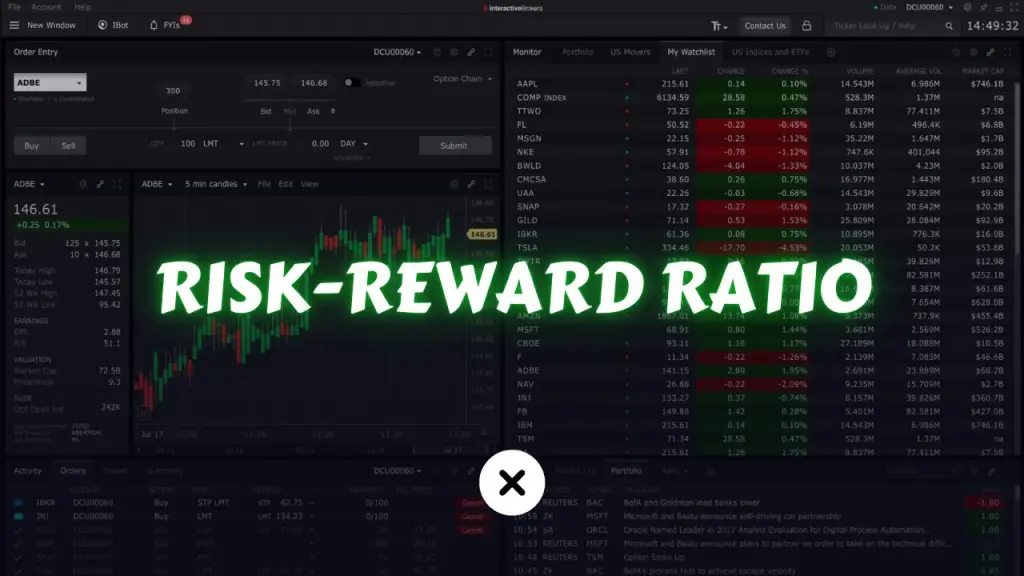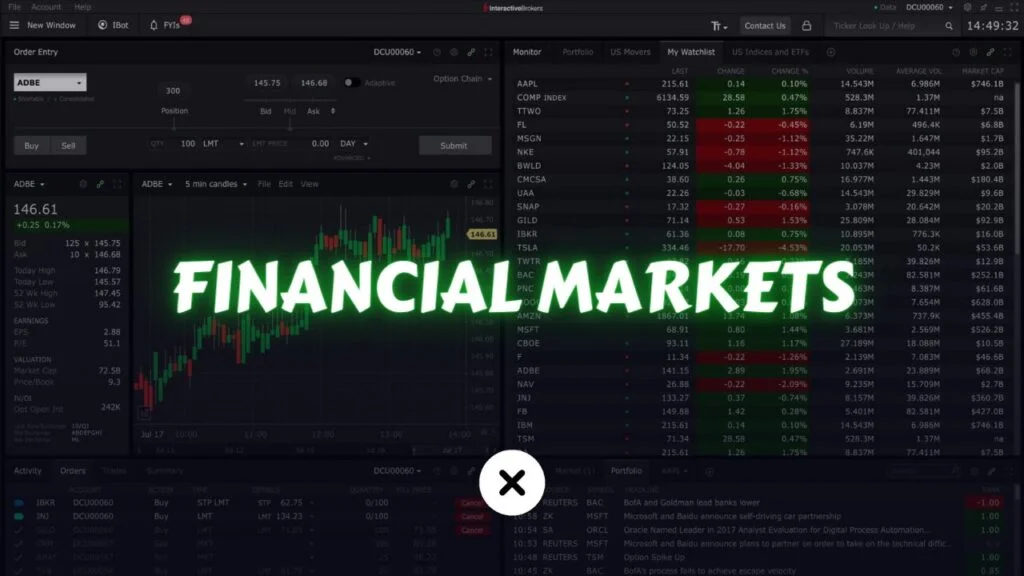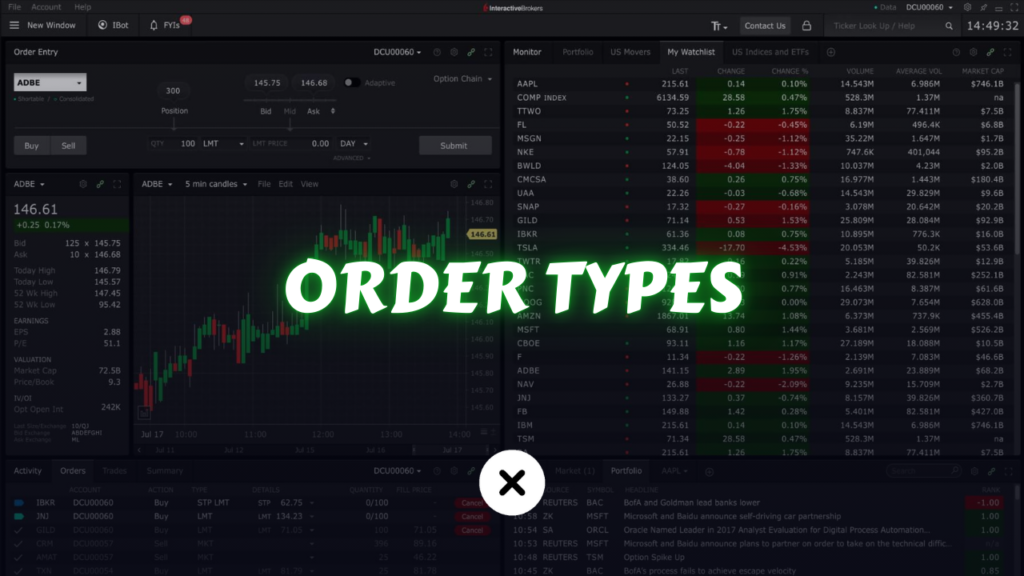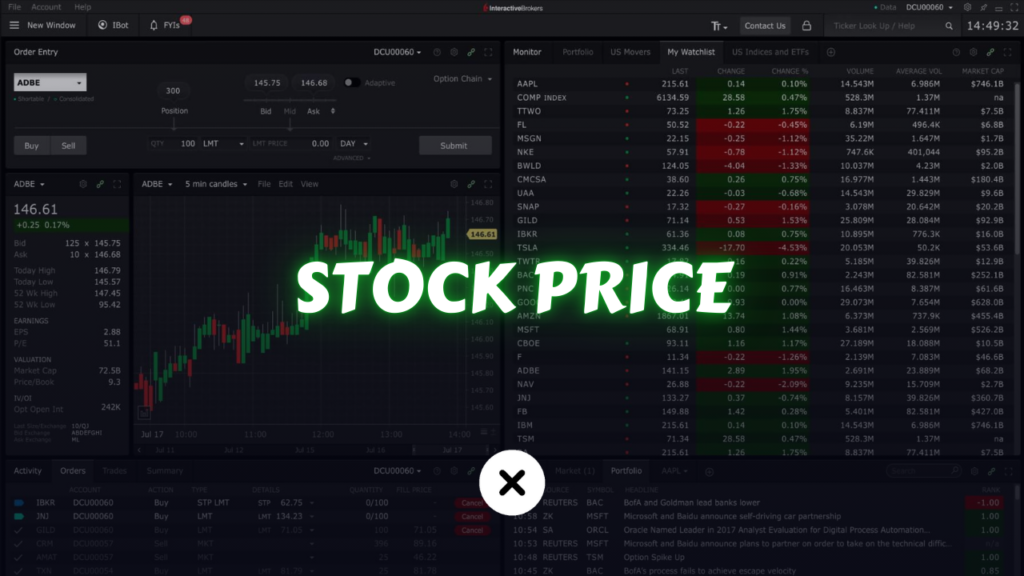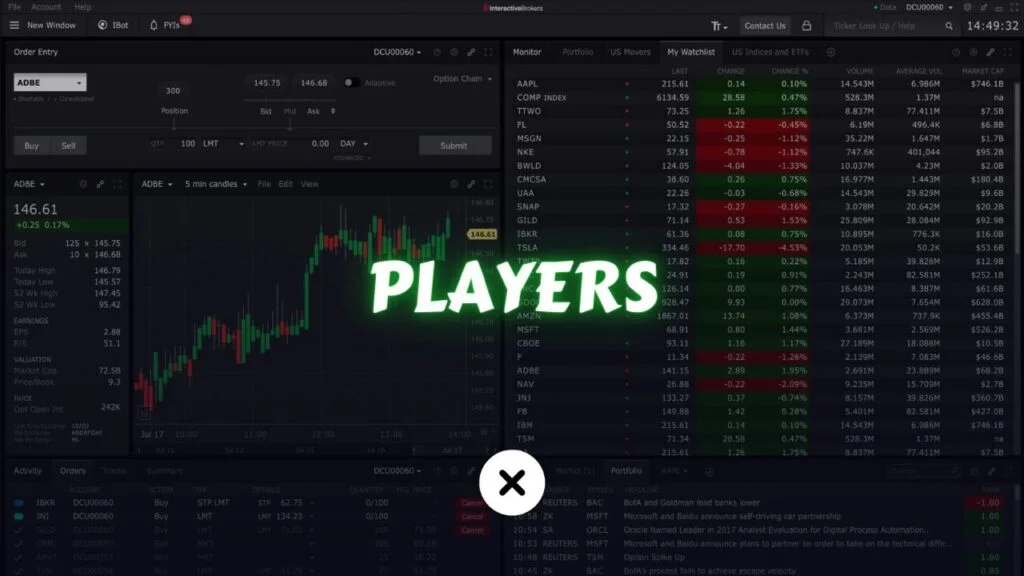Managing risk is the bedrock of successful trading, whether you’re a seasoned professional or just beginning your journey in the financial markets. One of the most critical elements of risk management is understanding and applying the risk-reward ratio. In essence, the risk-reward ratio provides traders with a framework to compare the potential profit of a trade to its potential loss, thereby helping them make calculated decisions about when to enter and exit positions.
This concept underpins all forms of trading—stocks, forex, commodities, and cryptocurrencies—because it influences how much capital you might lose if the market goes against you and how much you stand to gain if you’re correct. A thorough understanding of the risk-reward ratio not only helps you maximize profitability but also shields you from catastrophic losses that can deplete your trading account.
In this in-depth guide, we’ll explore everything you need to know about the risk-reward ratio, from the theoretical background and core calculations to real-world examples and advanced techniques. By the end of this article, you’ll have a robust understanding of how to use the risk-reward ratio to your advantage in virtually any market scenario.
Table of Contents
What Is Risk-Reward Ratio?

The risk-reward ratio is a simple but powerful concept that compares the amount of money you stand to lose (the risk) if a trade goes wrong, to the amount of money you stand to gain (the reward) if a trade goes right. It is often expressed as a ratio, such as 1:2, 1:3, or 2:1, depending on whether you’re describing risk first or reward first.
- Risk: The potential loss you might incur if the market moves against your position.
- Reward: The potential profit you might earn if the market moves in your favor.
For example, if you risk 1% of your account on a trade with the aim of making 2% profit, your risk-reward ratio is 1:2. This ratio suggests that if you lose a trade, you lose 1% of your account, but if you win, you gain 2%.
The great advantage of framing trades in terms of risk-reward is that it promotes consistency and discipline. Traders who carefully think about both sides of a trade tend to be more prepared for adverse market movements and less driven by emotional reactions.
Why the Risk-Reward Ratio Matters
The risk-reward ratio helps traders balance their potential profits with the inherent uncertainty of the financial markets. Below are several reasons why it’s so critical to integrate a well-defined risk-reward strategy into your trading plan:
- Preservation of Capital
By emphasizing how much you stand to lose on any trade, risk-reward calculations encourage you to preserve capital. Preserving your capital is crucial for long-term success because heavy losses can derail your ability to trade effectively. - Emotional Control
When you have a clear metric guiding your entry and exit, you’re less likely to make emotional or impulsive decisions. Risk-reward discipline can help curb fear and greed—two powerful emotions that often lead to costly mistakes. - Strategic Advantage
Knowing that certain trades offer better or worse potential payouts helps you remain selective. As a result, you concentrate on setups that truly align with your trading strategy and maximize your probability of success. - Win Rate Optimization
A favorable risk-reward ratio can reduce the overall win rate you need to be profitable. For instance, if you consistently trade with a 1:3 risk-reward ratio, you can theoretically be profitable even if you win fewer than half of your trades. - Long-Term Consistency
Professional traders often emphasize consistency over short-term gains. Having a well-structured risk-reward framework fosters sustainable profits and mitigates the impact of inevitable drawdowns.
In short, the risk-reward ratio is a cornerstone of professional trading strategy. It helps you filter potential trades based on profitability expectations while safeguarding your capital from impulsive or high-risk decisions.
Key Components of the Risk-Reward Ratio
To master the risk-reward ratio, it’s important to understand its core components and how they interconnect within a trading plan.
1. Entry Price
The entry price is the price at which you open a position. It sets the baseline for determining both your risk and potential reward. Traders often rely on technical analysis (e.g., support and resistance lines, moving averages, and chart patterns) or fundamental analysis to choose an optimal entry point.
2. Stop-Loss Price
A stop-loss order is a predefined order to close a position when the market reaches a certain price level that indicates your trade idea has failed. This stop-loss level is essential for defining your risk, as it sets the maximum loss you’re willing to tolerate.
- Placing your stop-loss below strong support (for a long position) or above strong resistance (for a short position) is a common practice among technical traders.
- The distance between your entry price and stop-loss price represents the risk per share (or per contract, lot, etc.), which you’ll combine with position sizing to ensure you don’t exceed your desired overall account risk.
3. Take-Profit Price
A take-profit level (or multiple targets) is a price level(s) where you plan to exit your trade and secure your gains. This price level underlines your reward. Traders commonly use:
- Technical targets based on chart patterns (like resistance areas, breakout points, pivot levels)
- Fundamental milestones (e.g., earnings announcements, industry news)
- A trailing stop approach that moves with the price to lock in profits if the market trends in your favor.
4. Position Size
Position sizing determines how many shares, lots, or contracts you trade. It is tied closely to your overall risk tolerance, as each position’s size magnifies or reduces your potential losses and gains. Traders often use formulas or calculators that factor in the distance between entry and stop-loss to determine an appropriate position size.
5. Reward Target
Finally, your reward target is the difference between your entry price and your take-profit price. If this reward aligns with your desired ratio in relation to the risk, then the trade becomes more attractive from a risk-reward perspective.
Understanding each of these components clarifies the essential nature of balancing risk and reward. Without a well-defined plan for each of these elements, the risk-reward ratio concept loses much of its potency.
Calculating Risk-Reward Ratio: Step-by-Step
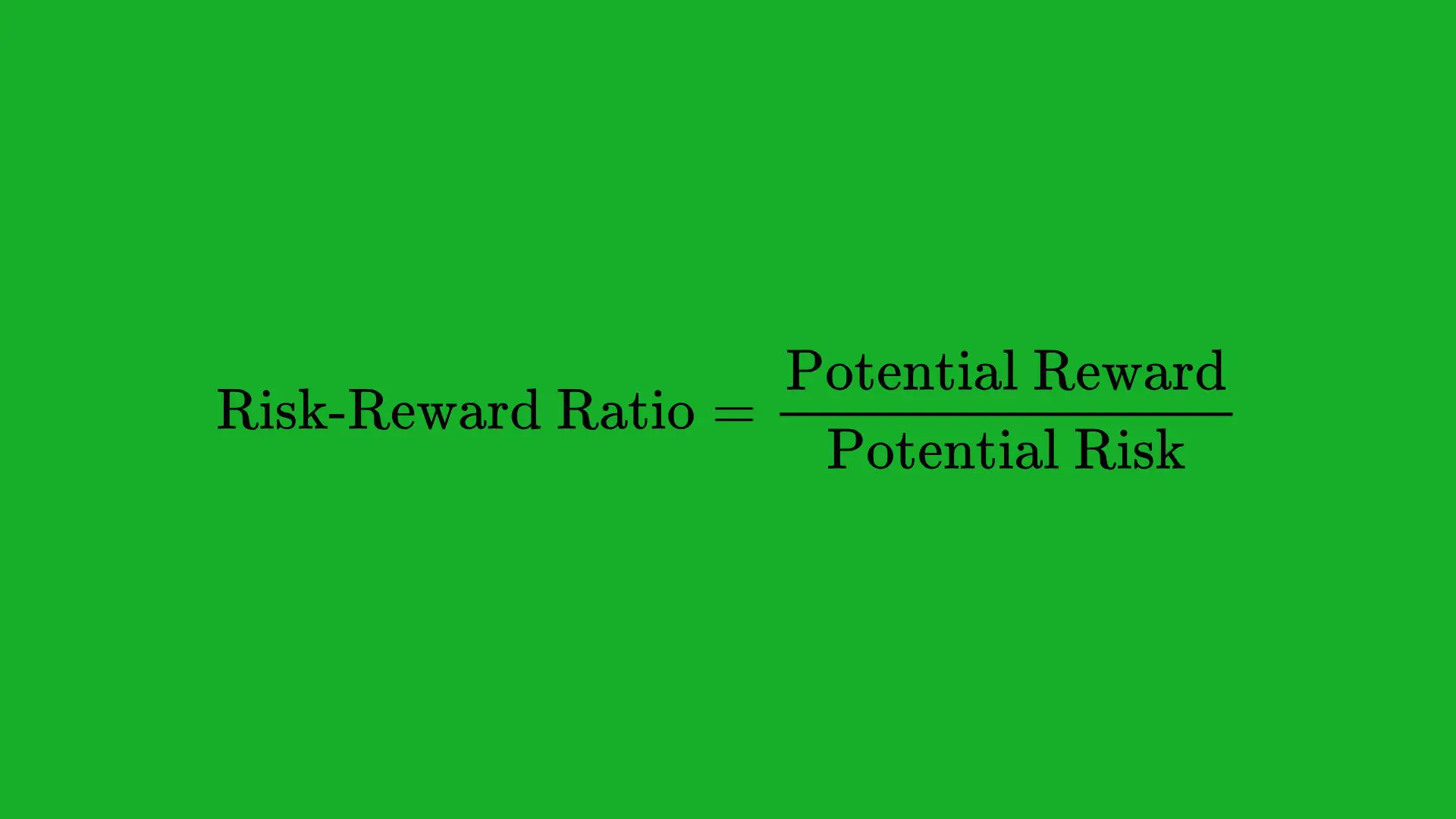
To illustrate how to calculate the risk-reward ratio step-by-step, let’s walk through a hypothetical example in a stock trading scenario.
- Identify the Entry Price
Suppose you want to buy a stock trading at $100. - Determine Your Stop-Loss
Your technical analysis suggests that if the stock falls below $95, it invalidates your bullish thesis. Therefore, you set your stop-loss at $95.- Potential Risk = Entry Price – Stop-Loss Price = $100 – $95 = $5 per share.
- Set Your Take-Profit Target
Based on overhead resistance or another indicator, you believe the stock could rise to $115. Therefore, you set your take-profit at $115.- Potential Reward = Take-Profit Price – Entry Price = $115 – $100 = $15 per share.
- Calculate the Ratio
- Risk = $5
- Reward = $15
- Risk-Reward Ratio = $5 : $15 = 1:3
This 1:3 ratio means for every $1 you risk, you aim to make $3. If you trade 100 shares, your total risk would be $5 x 100 = $500, and your total potential reward would be $15 x 100 = $1,500.
If this ratio meets or exceeds your minimum threshold for acceptable trades—say you won’t take anything below a 1:2—then you’ll likely deem it a high-probability setup.
Common Risk-Reward Ratios in Practice
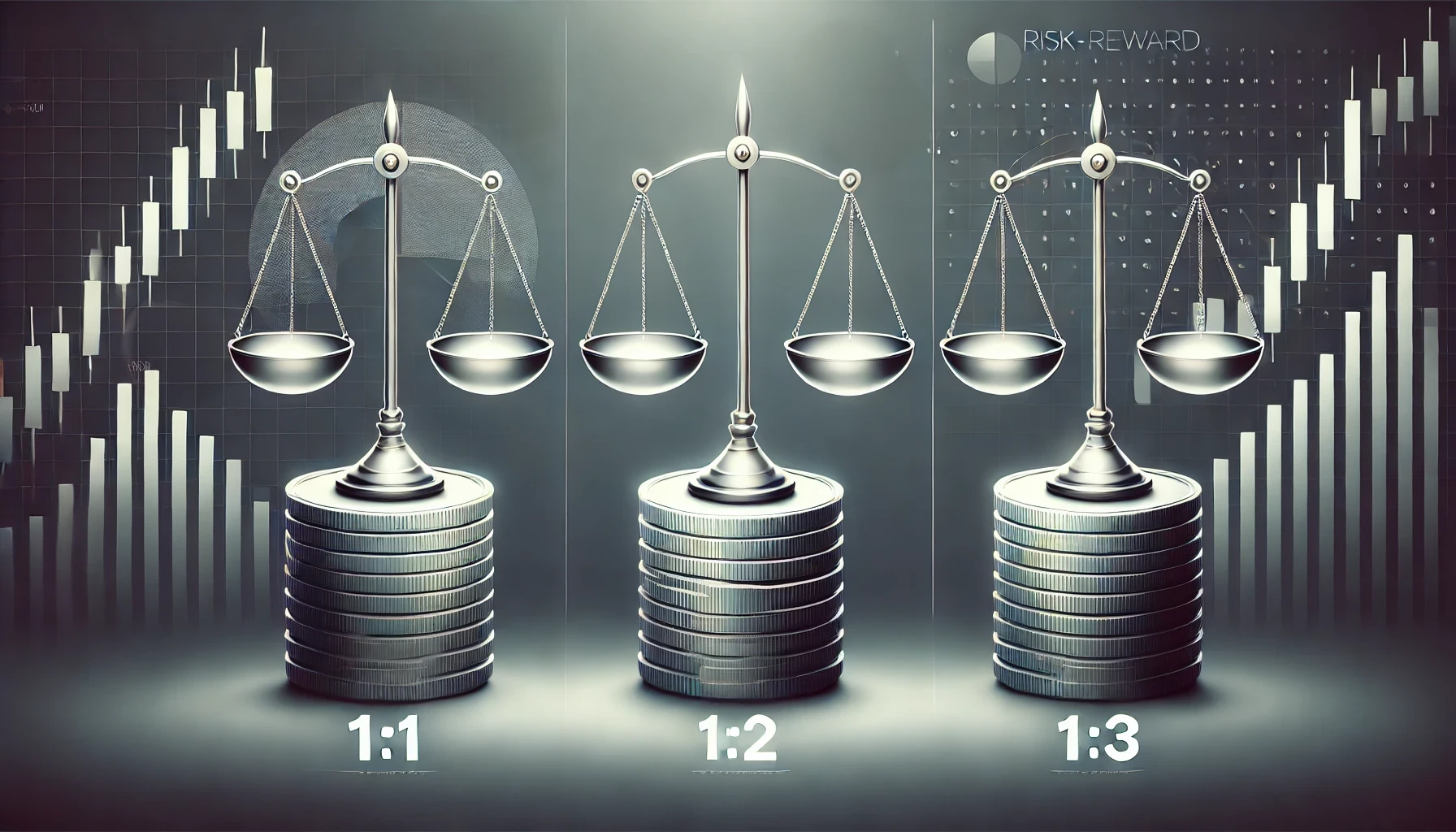
Though there is no absolute rule, many traders have benchmarks that guide which trades are worth taking. Here are some typical risk-reward ratios you might encounter:
- 1:1
- This means you’re risking $1 to make $1.
- While this may seem balanced, you typically need a higher win rate to remain profitable over the long term, given trading costs and occasional slippage.
- 1:2
- You risk $1 to make $2.
- A moderate ratio that many traders use as a minimum. It offers a decent balance between risk and potential reward while still being achievable in various market conditions.
- 1:3
- You risk $1 to make $3.
- This is often considered a good sweet spot by swing traders who look for favorable setups. You need a lower win rate to be consistently profitable.
- 1:4 or 1:5
- Higher ratios can yield significant profits but often come with a lower probability of success, as you’re generally setting more ambitious price targets.
- 2:1 (if expressed as risk:reward, it translates to risking $2 for every $1 of potential profit)
- This is not very common as a desired setup because you are risking more than you stand to gain. However, some scalpers or high-frequency traders might rely on high success rates to compensate for unfavorable risk-reward ratios.
Selecting an appropriate ratio depends heavily on your trading style, market conditions, and win rate. The more robust your analysis and your edge in the market, the higher the risk-reward ratios you can realistically aim for.
Risk-Reward Ratio vs Win Rate
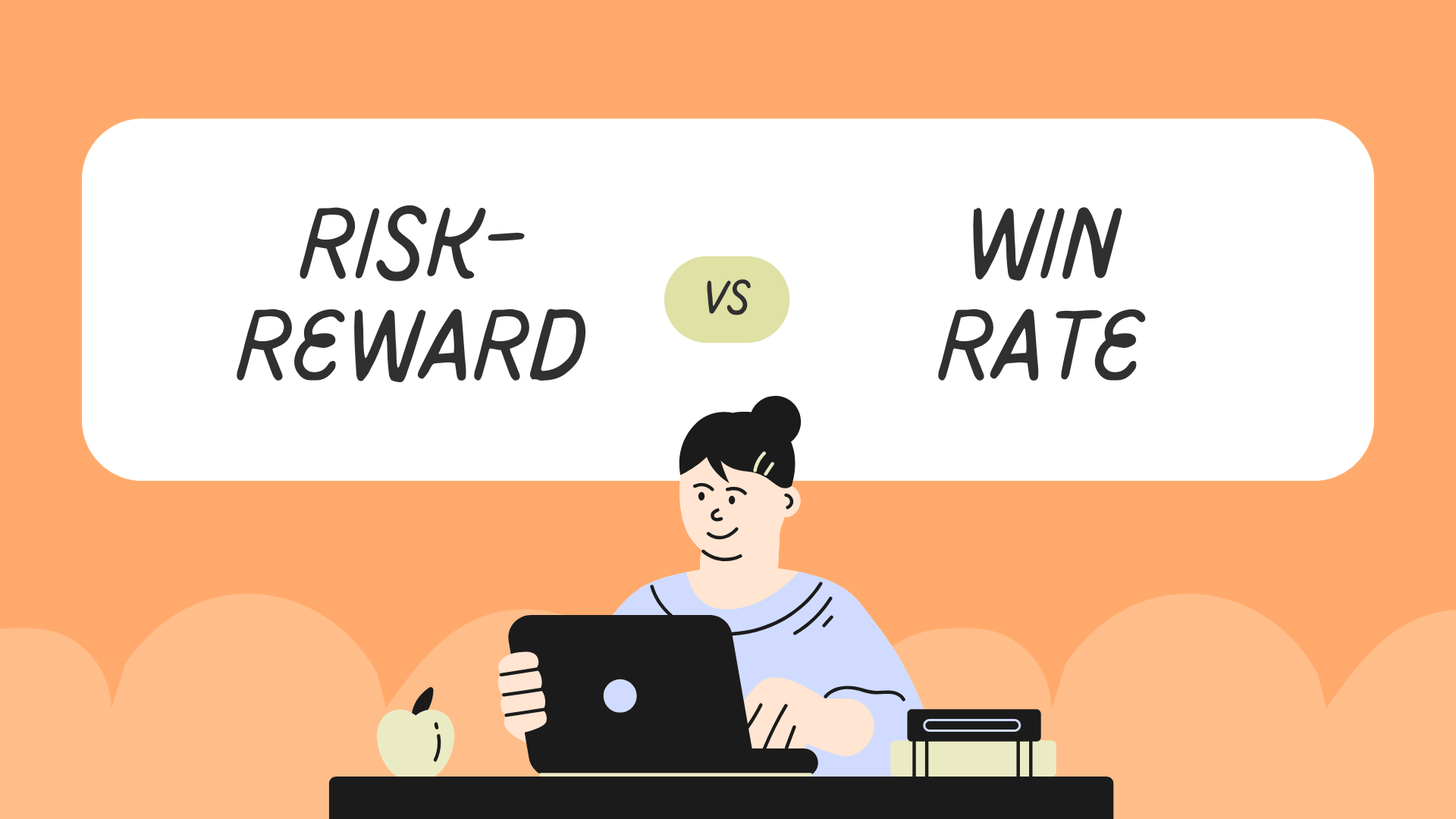
An important factor to keep in mind is the relationship between risk-reward ratios and win rate, which is the percentage of your trades that end in profit. A high win rate can offset a lower risk-reward ratio, whereas a higher risk-reward ratio can offset a low win rate.
1. Mathematical Overview
- Win Rate: The percentage of winning trades.
- Risk-Reward Ratio: The proportion of expected gain to expected loss.
Your overall profitability can be approximated with the following formula:
Expected Value = (Win Rate × Average Win) − ((1−Win Rate) × Average Loss)
If your risk-reward ratio is 1:2 and you have a 50% win rate, your expected value is:
0.5 × 2R − 0.5 × R = R × (1−0.5) = 0.5 R
Where R is your risk per trade. In this scenario, you’re net positive.
2. Finding the Right Mix
- If you’re comfortable with a win rate of around 40%, you might seek a higher risk-reward ratio—1:3 or more—to ensure that your winners offset your losers.
- If you have a trading strategy that wins 70-80% of the time, you can get by with a 1:1 risk-reward ratio.
Ultimately, the key is striking a balance. Some traders thrive on fewer but larger wins, while others depend on smaller but more frequent gains. Tailor your approach to what you do best, as success in trading also depends on personal strengths, risk tolerance, and market knowledge.
Balancing Risk-Reward in Different Trading Styles

Your preferred trading style—scalping, day trading, swing trading, or position trading—often dictates the type of risk-reward ratios you should pursue.
1. Scalping
- Time Horizon: Seconds to minutes.
- Typical Risk-Reward: Often near 1:1 or even worse, because scalpers rely on extremely high win rates.
- Trade Frequency: Very high, which can lead to substantial cumulative gains, provided the spreads and commissions do not eat away profits.
2. Day Trading
- Time Horizon: Minutes to hours, but rarely overnight.
- Typical Risk-Reward: Usually 1:1 to 1:3.
- Focus: Quick reaction to intraday volatility, often based on technical analysis such as candlestick patterns, momentum indicators, and level II data.
3. Swing Trading
- Time Horizon: Days to weeks.
- Typical Risk-Reward: More commonly 1:2, 1:3, or even higher.
- Position Sizing: Slightly smaller position sizes to weather overnight gaps, but well-defined technical or fundamental reason for the trades.
4. Position Trading
- Time Horizon: Weeks to months or even years.
- Typical Risk-Reward: Potentially very high, 1:3, 1:5, or beyond, given the extended timeline.
- Drawbacks: Larger swings in the market and overnight risk can test a trader’s patience and emotional resilience.
Each style carries its own advantages and requires different risk management approaches. A key to long-term success is ensuring your risk-reward preferences align with the market dynamics and your own trading psychology.
Position Sizing and Risk Management

Even if you identify a high-probability trade setup with a great risk-reward ratio, poor position sizing can undermine your efforts. Proper position sizing is what brings theory to life, ensuring that your capital risk remains consistent with your goals.
1. The 1-2% Rule
A widely accepted guideline is never to risk more than 1-2% of your total trading capital on a single trade. This helps you absorb losing streaks without significantly depleting your account. For instance, if you have a $10,000 trading account and use a 2% risk threshold, you’ll risk $200 per trade.
2. Position Size Calculation
Assume you decide to place a stop-loss $5 away from your entry. If you’re willing to risk $200 total on the trade, you’d calculate:
Position Size= (Total Risk / Risk per Share) = (200 / 5) = 40 shares
This way, if the trade moves against you and your stop-loss is triggered, you’ll lose around $200, which matches your risk threshold.
3. Monitoring Overall Exposure
Traders with multiple positions need to monitor aggregate risk, ensuring they aren’t over-leveraged across different trades. For example, if you have five open trades, each risking 2% of your account, your total risk is 10%. This might be higher than desired, especially if the trades are correlated (e.g., all in the same sector or currency pair).
4. Adjusting Stops Dynamically
Active traders sometimes move their stop-loss to breakeven or trail the stop to lock in profits if the trade moves favorably. While this can boost your risk-reward profile, frequent trailing stops can also lead to getting stopped out prematurely. Striking the right balance is an art that often comes with experience and backtesting.
Setting Stop-Loss and Take-Profit Levels
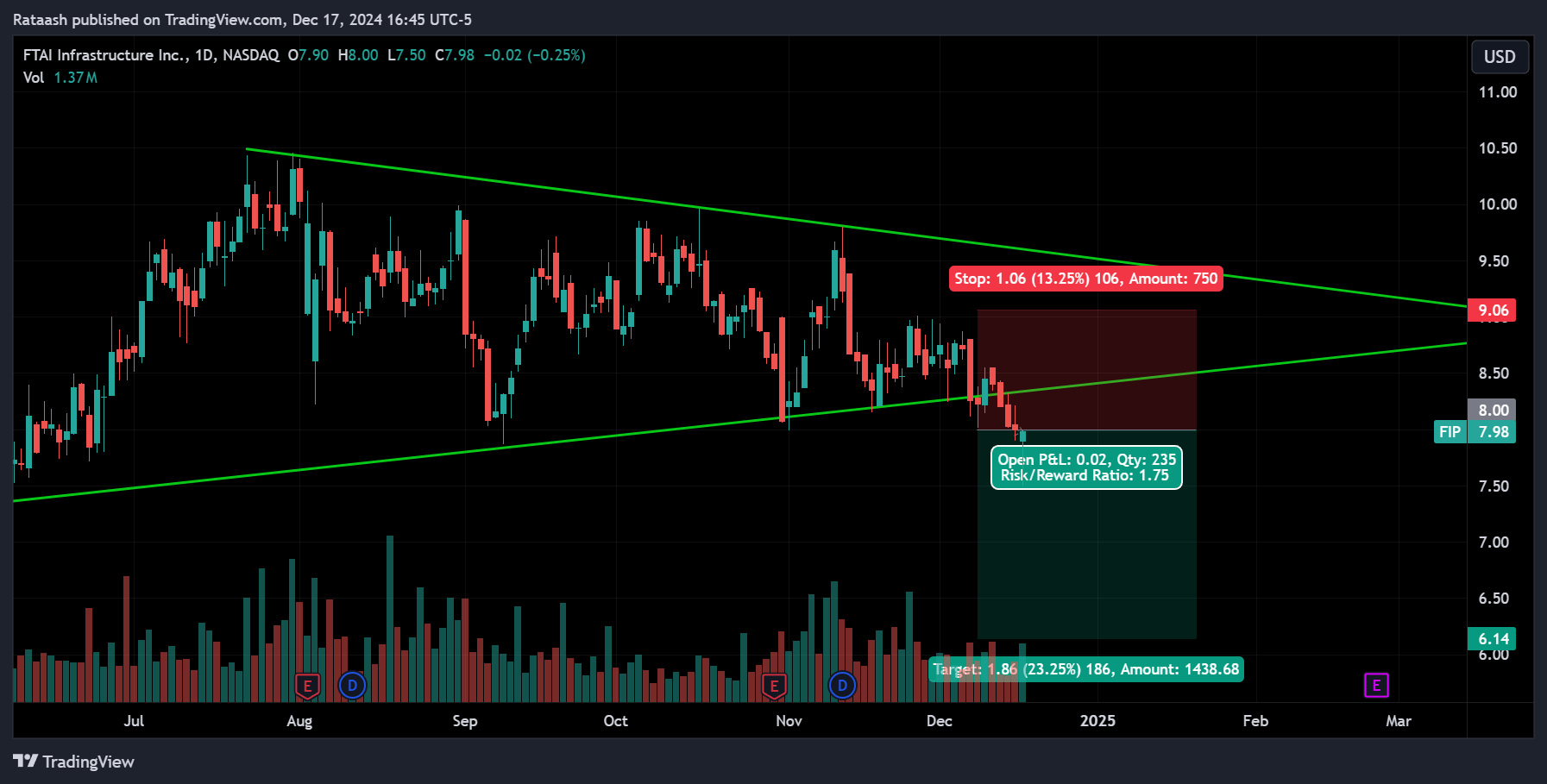
Your stop-loss and take-profit (TP) orders are the linchpins that cement your risk-reward ratio in place. Setting them incorrectly can lead to missed opportunities or unnecessary losses.
1. Technical Analysis for Stop-Loss Placement
Common methods for choosing stop-loss levels include:
- Support and Resistance: Placing stops just below support or above resistance ensures that if these levels fail, your trade thesis is likely invalid.
- ATR (Average True Range): Many traders use an ATR multiple to account for market volatility. For example, you might set your stop-loss 1.5× ATR away from your entry.
- Moving Averages: For trend traders, placing a stop-loss below a moving average (like the 50-day or 200-day) can serve as a dynamic line in the sand.
2. Technical Analysis for Take-Profit Placement
Deciding where to exit a winning position is equally critical. Traders often use:
- Previous Swing Highs/ Lows: These are potential resistance or support levels that can stall a price move.
- Fibonacci Extensions: Fibonacci retracements and extensions can help identify probable price targets.
- Chart Patterns: A measured move from a breakout point (e.g., the height of a triangle or head and shoulders pattern) can guide your TP.
3. Multiple Profit Targets
In some strategies, you can scale out of a winning trade at multiple targets. For instance:
- Sell half your position at a 1:1 ratio.
- Move your stop-loss to breakeven for the remainder.
- Let the trade run to a 1:3 ratio or beyond.
This hybrid approach can lock in partial gains while still leaving room for bigger profits. However, scaling out also dilutes some of the potential profit if the trade keeps trending in your favor.
Psychology and Discipline: The Human Factor

A sound risk-reward strategy is only as effective as the trader’s discipline in following it. Emotions can derail even the best-laid plans.
1. Fear of Losing
Fear often prompts traders to set very tight stops, which can lead to getting “whipsawed” in choppy markets. Fear can also discourage traders from taking valid setups that meet their risk-reward criteria.
2. Greed and Over-Targeting
Greed can lead traders to move their take-profit levels arbitrarily higher or remove them altogether, chasing bigger gains. This often backfires when a retracement eliminates potential profits.
3. Emotional Attachment to Trades
Sometimes traders develop a personal attachment to a particular stock or asset (especially in crypto). They might refuse to accept the stop-loss or move it further away to avoid a “paper” loss, ultimately causing more damage to their account.
4. Overcoming Emotional Biases
- Predefine Your Plan: Set your entry, stop-loss, and take-profit levels before entering a trade.
- Use Alerts or Automated Orders: Hard stop-losses and limit orders remove human emotion from the equation.
- Practice Mindfulness: Trading psychology is often overlooked. Techniques like journaling, meditation, or therapy can help traders maintain emotional equilibrium.
In the end, a well-defined risk-reward framework is only effective if you follow it diligently.
Risk-Reward in Different Market Conditions
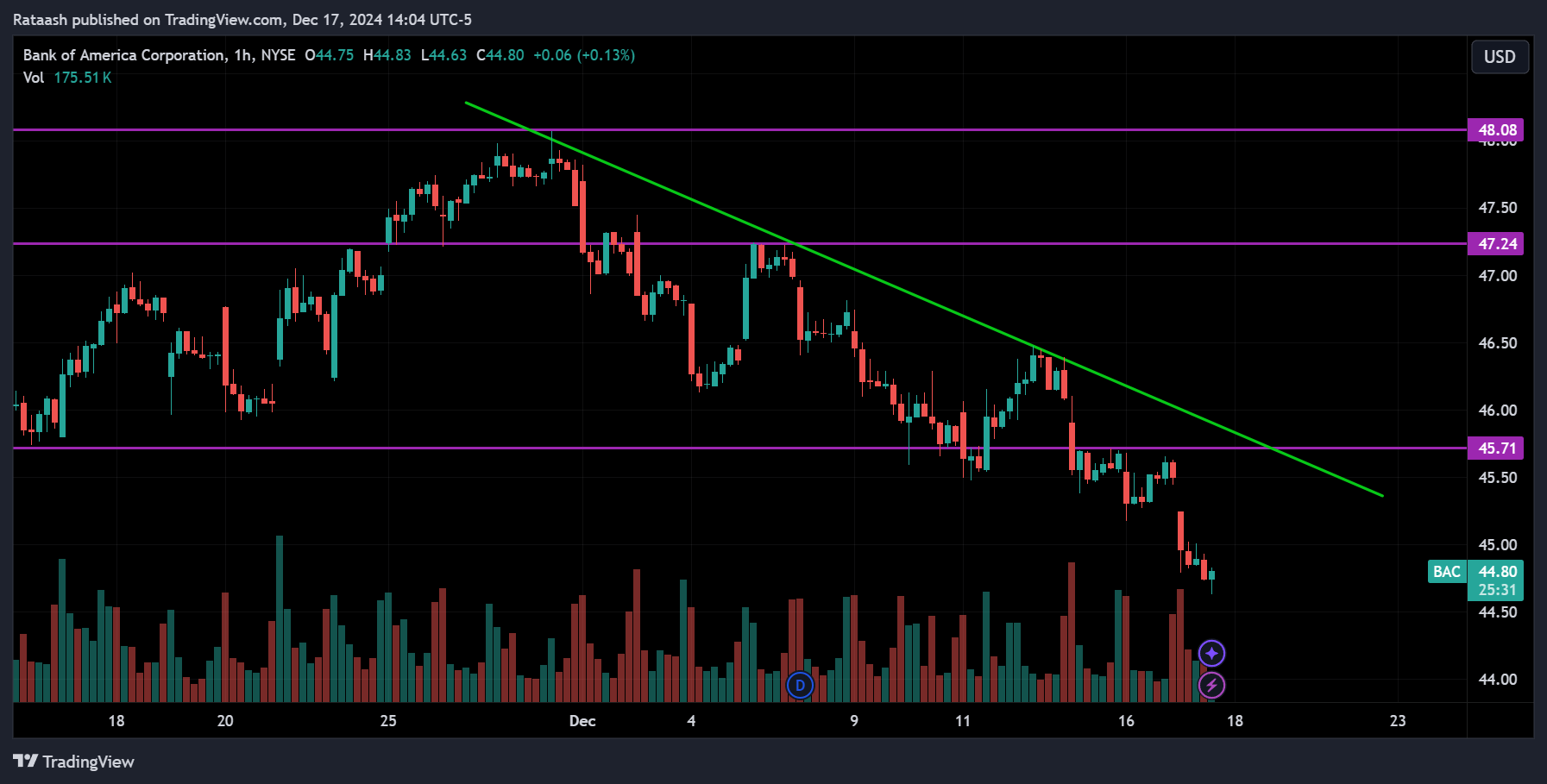
Financial markets are dynamic, shifting between periods of high volatility and low volatility, trending and range-bound conditions. Adapting your risk-reward approach accordingly can significantly improve your results.
1. High Volatility Markets
- Opportunities: Rapid price swings can create large moves that align with higher risk-reward setups (like 1:3, 1:4, or more).
- Challenges: High volatility also increases the likelihood of large drawdowns if your stop-loss is too close.
2. Low Volatility / Range-Bound Markets
- Opportunities: You might take advantage of short bursts of momentum within the trading range, aiming for smaller profits with tight stops.
- Challenges: Achieving high risk-reward ratios can be difficult if the asset moves in a narrow range.
3. Trending vs. Choppy Markets
- Trending: You may find more success with higher risk-reward ratios if you catch a strong trend early. You can also trail your stop-loss to lock in profits.
- Choppy: In sideways or uncertain market conditions, a conservative approach with moderate risk-reward ratios might be more prudent, as false breakouts are common.
Being flexible and adjusting your stop-loss distance, position sizing, and profit targets in response to prevailing market conditions is often more effective than rigidly sticking to one ratio in all environments.
Practical Examples and Case Studies
Forex Example: EUR/USD
- Scenario: You anticipate the EUR/USD pair will rise from 1.1000 to 1.1150, based on a bullish chart pattern and positive Eurozone economic data.
- Stop-Loss: You place a stop-loss at 1.0950, 50 pips away from your entry.
- Take-Profit: You target 1.1150, which is 150 pips away from your entry.
- Risk-Reward Ratio: 1:3 (50 pips risk vs. 150 pips reward).
If your analysis is correct, you stand to triple what you risked if the trade moves in your favor. Even if you only win 40% of the time with such setups, you could still end up profitable.
Stock Example: Breakout Trade
- Scenario: A technology stock is consolidating around $50. Your technical analysis indicates that a break above $52 could trigger a strong momentum move towards $60.
- Stop-Loss: You set your stop-loss at $49 to account for a potential false breakout.
- Entry: At $52, right as it clears the consolidation.
- Take-Profit: $60, based on the measured move of the previous price range.
- Risk-Reward: (52 – 49) : (60 – 52) = 3 : 8 = 1:2.67
You risk $3 to potentially make $8 per share. If you stay consistent with such trades, you can maintain profitability even with a moderate win rate.
Cryptocurrency Example: Swing Trade in Bitcoin
- Scenario: Bitcoin is trading at $30,000, and a bullish divergence on the daily RSI suggests a potential rebound to $34,000.
- Stop-Loss: You set a stop-loss at $28,000, anticipating that a move below $28,000 might invalidate the bullish divergence.
- Take-Profit: $34,000, which seems to be a strong resistance based on previous price action.
- Risk-Reward: (30,000 – 28,000) : (34,000 – 30,000) = 2,000 : 4,000 = 1:2
Once again, you’re risking $2,000 per BTC for the chance to gain $4,000 per BTC, which fits within a comfortable 1:2 ratio.
Common Mistakes and Pitfalls to Avoid
Even traders who grasp the concept of risk-reward ratio can fall into traps that undermine their success. Here are some pitfalls to be mindful of:
- Ignoring Market Context
A 1:3 ratio is only valuable if it aligns with realistic market movements. Setting arbitrary profit targets without analyzing support/resistance or market volatility can lead to disappointment. - Moving Stop-Loss Further
Extending your stop-loss to avoid being stopped out can quickly inflate your risk. This not only skews your risk-reward ratio but can cause significant losses. - Failing to Adjust for Volatility
If volatility picks up, placing a stop-loss too close might get you stopped out too often. Conversely, if volatility drops, setting a wide stop-loss might not be efficient. - Overtrading
Even if a trade has a decent risk-reward ratio, taking too many trades in quick succession can lead to sloppy decision-making and increased transaction costs. - Not Calculating Proper Position Sizes
Eye-balling or arbitrarily choosing your position size can result in risking far more than you intended, or not risking enough to make a difference. - Inconsistent Application
Switching between risk-reward strategies without rhyme or reason (e.g., 1:2 one day, 1:1 the next, 1:5 another day) can make it hard to evaluate your performance metrics over time.
Avoiding these mistakes will help you remain consistent, disciplined, and profitable in the long run.
Tools and Resources for Managing Risk-Reward

1. Trading Platforms
Most professional trading platforms—such as MetaTrader, NinjaTrader, or TradingView—allow you to visually place your stop-loss and take-profit on the chart. This makes it straightforward to calculate your approximate risk-reward ratio.
2. Position Size Calculators
Position size calculators (available online or built into certain trading applications) can help you determine how many shares or lots to trade based on your account size, risk percentage, and stop-loss distance.
3. Journaling Software
Keeping a trade journal is critical for long-term improvement. You can track your planned risk-reward, actual outcomes, and the reasons behind each trade. Over time, patterns emerge that can highlight areas for improvement.
4. Volatility Indicators
Tools such as the Average True Range (ATR), Bollinger Bands, and Implied Volatility (for options) can help you adapt your stop-loss and take-profit levels to the current market environment.
5. Backtesting and Forward Testing
Before applying a particular risk-reward strategy in real-time, backtest it on historical data to see how it would have performed. Then, forward test (paper trading or trading with small position sizes) to validate the strategy in live market conditions.
6. Educational Resources
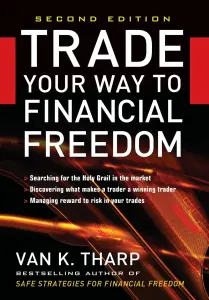
- Books: “Trade Your Way to Financial Freedom” by Van K. Tharp emphasizes position sizing and risk management.
- Online Communities: Forex Factory, Reddit’s /r/Daytrading, and other communities often discuss risk-reward techniques and examples.
- Courses and Mentorship: Many professional traders and educational platforms offer in-depth programs focusing on managing risk and psychology.
Conclusion
The risk-reward ratio is much more than a mere number or an abstract concept—it’s a guiding principle that shapes how professional traders approach the markets. By clearly defining how much you’re willing to lose versus how much you aim to gain on each trade, you set the foundation for disciplined, methodical decision-making.
Key Takeaways
- Clarity of Purpose: A well-defined risk-reward ratio helps you enter each trade with a clear sense of your potential losses and gains.
- Capital Preservation: Placing appropriate stop-losses and understanding position sizing ensures that no single losing trade can jeopardize your overall account.
- Profit Optimization: Knowing your desired profit target—and making sure it aligns with market conditions—can help you avoid leaving profits on the table or overstaying in a trade that’s run its course.
- Emotional Management: Having a predefined plan for every trade can help you remain calm and systematic, even during periods of volatility or drawdowns.
- Long-Term Consistency: Regardless of whether you adopt a scalping, day trading, or swing trading approach, consistently applying a robust risk-reward framework is one of the surest paths to achieving sustainable results in the markets.
Final Word
Mastering the risk-reward ratio is not a one-time event but an ongoing process of refinement. It is one of the essential metrics for trading success, helping traders balance profitability and risk effectively. As your trading skills evolve, you’ll uncover nuances—such as adjusting targets for varying market conditions and fine-tuning position sizes—to enhance your trading edge.
By integrating the risk-reward ratio into a broader framework of rigorous technical or fundamental analysis, a solid trading plan, and unwavering discipline, you position yourself for long-term success. While the journey is rarely linear and drawdowns are inevitable, a strategic focus on key metrics like the risk-reward ratio provides a robust foundation for thriving in the competitive world of trading.
FAQ: The Trader’s Guide to Risk-Reward Ratio
1. What is a good risk-reward ratio for trading?
A good risk-reward ratio depends on your trading style and strategy, but many traders aim for at least 1:2 or 1:3. This means you risk $1 to potentially gain $2 or $3. Higher ratios offer better long-term profitability, even with a lower win rate.
2. How do I calculate the risk-reward ratio?
To calculate the risk-reward ratio, compare your potential loss (difference between entry price and stop-loss) to your potential gain (difference between entry price and take-profit). For example, if your stop-loss is $2 below your entry and your take-profit is $6 above, your ratio is 1:3.
3. Can I use the same risk-reward ratio for all trades?
While consistency is important, it’s better to adapt your risk-reward ratio to the market conditions and specific trade setup. For example, in high-volatility markets, you might aim for higher ratios like 1:4, while in range-bound conditions, a 1:2 ratio might be more realistic.
4. What’s the relationship between win rate and risk-reward ratio?
Win rate and risk-reward ratio work together to determine profitability. A high risk-reward ratio allows you to remain profitable with a lower win rate. For example, with a 1:3 ratio, you only need to win about 25% of your trades to break even.
5. What tools can help manage risk-reward ratios?
Trading platforms like MetaTrader, TradingView, and Thinkorswim often provide features to set stop-loss and take-profit levels visually on charts. Position size calculators, ATR indicators, and journaling tools are also useful for maintaining consistent risk management.
6. What are common mistakes in applying risk-reward ratios?
Common mistakes include:
- Setting arbitrary targets without considering market context.
- Moving stop-loss levels to avoid losses, which increases risk.
- Overtrading without proper risk assessment.
- Ignoring position sizing and overall portfolio exposure.
7. Why is the risk-reward ratio important in trading?
The risk-reward ratio helps you make informed decisions about which trades to take, ensures capital preservation, and promotes long-term profitability by balancing potential losses and gains.
